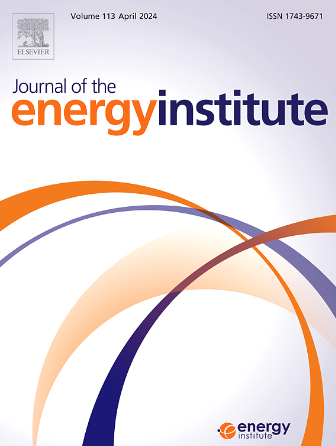点火和活化能分布对柴油-氨-天然气发动机燃烧和排放特性的影响
IF 6.2
2区 工程技术
Q2 ENERGY & FUELS
引用次数: 0
摘要
为了提高氨-柴油发动机的性能并减少排放,天然气被用作柴油燃料的部分替代品。这种替代可加快氨燃料的燃烧速度,从而提高发动机效率并减少排放。本研究通过模拟研究了点火能量(柴油量)和活化能(天然气量)分配比例的变化如何影响发动机的燃烧和排放特性。研究设定了六组工作条件,点火能量从 24 毫克到 4 毫克不等。研究结果表明,用活化能替代部分点火能可提高氨的燃烧效率,提高发动机的指示热效率并减少氨滑移。本研究确定的最佳运行条件为 D16/N8,热效率为 51.0%。与不添加天然气的情况相比,氮氧化物的排放量有所增加,而其他污染物则显著减少。其中,一氧化二氮的排放量减少了 97%,温室气体(GHG)的排放量减少了 57.2%,氨滑移几乎消除,未燃烧损失极小。这项研究成果为进一步提高氨-柴油双燃料发动机的效率和减少排放提供了宝贵的见解。本文章由计算机程序翻译,如有差异,请以英文原文为准。
The impact of ignition and activation energy distribution on the combustion and emission characteristics of diesel-ammonia-natural gas engines
To enhance the performance and reduce emissions of ammonia-diesel engines, natural gas is employed as a partial substitute for diesel fuel. This substitution accelerates the combustion rate of ammonia fuel, resulting in improved engine efficiency and decreased emissions. This study investigates how variations in ignition energy (diesel quantity) and activation energy (natural gas quantity) distribution ratios affect engine combustion and emission characteristics through simulation. The study established six groups of operating conditions, with ignition energy ranging from 24 mg to 4 mg. The findings indicate that substituting part of the ignition energy with activation energy enhances the combustion efficiency of ammonia, increases the engine's indicated thermal efficiency and reduces ammonia slip. The optimal operating condition identified in this study is D16/N8, yielding a thermal efficiency of 51.0 %. Compared to the case without natural gas addition, NOx emissions increased, while other pollutants showed significant reductions. In particular, N2O emissions decreased by 97 %, greenhouse gas (GHG) emissions dropped by 57.2 %, ammonia slip was nearly eliminated, and unburned losses were minimal. The findings of this research offer valuable insights for further enhancing efficiency and reducing emissions in ammonia-diesel dual-fuel engines.
求助全文
通过发布文献求助,成功后即可免费获取论文全文。
去求助
来源期刊

Journal of The Energy Institute
工程技术-能源与燃料
CiteScore
10.60
自引率
5.30%
发文量
166
审稿时长
16 days
期刊介绍:
The Journal of the Energy Institute provides peer reviewed coverage of original high quality research on energy, engineering and technology.The coverage is broad and the main areas of interest include:
Combustion engineering and associated technologies; process heating; power generation; engines and propulsion; emissions and environmental pollution control; clean coal technologies; carbon abatement technologies
Emissions and environmental pollution control; safety and hazards;
Clean coal technologies; carbon abatement technologies, including carbon capture and storage, CCS;
Petroleum engineering and fuel quality, including storage and transport
Alternative energy sources; biomass utilisation and biomass conversion technologies; energy from waste, incineration and recycling
Energy conversion, energy recovery and energy efficiency; space heating, fuel cells, heat pumps and cooling systems
Energy storage
The journal''s coverage reflects changes in energy technology that result from the transition to more efficient energy production and end use together with reduced carbon emission.
 求助内容:
求助内容: 应助结果提醒方式:
应助结果提醒方式:


